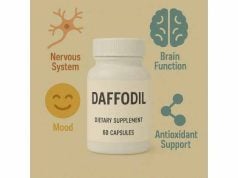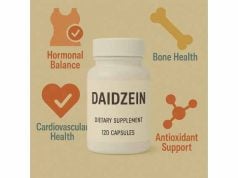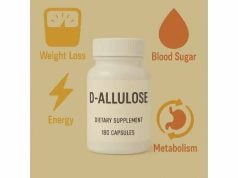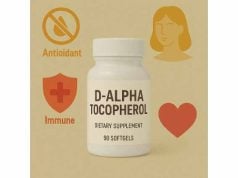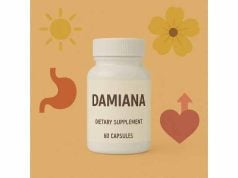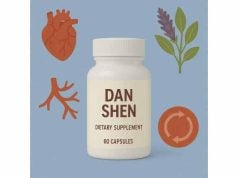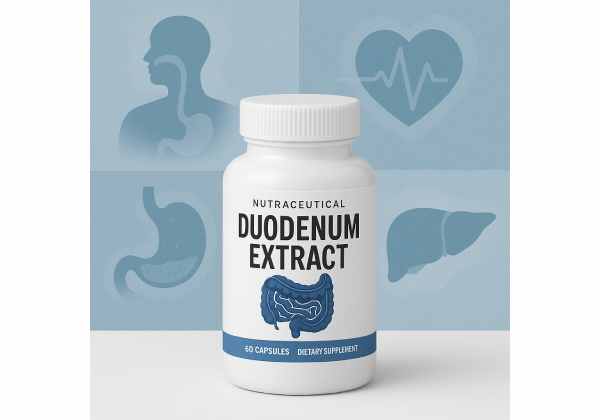
The idea behind duodenum extract—typically derived from bovine or porcine intestinal tissue—is simple but controversial: can concentrated tissue from the first part of the small intestine support digestion or gut health when taken orally? Marketers place it in the “glandulars” category alongside liver or thyroid extracts. In reality, human data are sparse, and most claims rely on physiology (the duodenum’s role in sensing nutrients and signaling hormones like secretin and cholecystokinin) rather than clinical trials. This guide separates mechanism from marketing. You will learn what duodenum extract is (and is not), where benefits are plausible, how to interpret labels, practical dosing guardrails when people choose to try it, and clear safety boundaries—including sourcing issues for animal tissues and why peptides in such extracts are largely digested before absorption.
Essential Insights for Duodenum Extract Users
- Main rationale is physiological (gut hormone signaling) but high-quality human trials on oral duodenum extract are lacking.
- Any protein or peptide constituents are mostly broken down during digestion; only small di- and tri-peptides are absorbed.
- If used, common label ranges are ~100–500 mg per capsule; a cautious trial would be 100–250 mg once daily with food.
- Safety caveat: avoid products without clear bovine/porcine sourcing controls and SRM (specified risk material) exclusions.
- Avoid if you have beef/pork allergy, are pregnant, are immunocompromised, or have prion-exposure concerns; discuss with your clinician first.
Table of Contents
- What is duodenum extract and does it work?
- What benefits are realistic and what are not?
- How to choose and use duodenum extract
- How much duodenum extract per day
- Side effects, interactions, and who should avoid
- What the evidence says overall
What is duodenum extract and does it work?
What it is. Duodenum extract is an animal-derived dietary supplement typically made from freeze-dried or solvent-extracted tissue from the duodenum—the first 20–30 cm of small intestine where acidic chyme from the stomach mixes with bile and pancreatic secretions. Labels may read “duodenum concentrate,” “duodenal tissue,” “intestinal PMG/protein fraction,” or “bovine/porcine duodenum.” Products often appear in multi-ingredient “glandular” blends with pancreas, stomach, or liver.
What the duodenum does in people. The human duodenum is a sensor and switchboard for digestion. Specialized cells detect fat, protein, and acid, then release peptide hormones such as secretin and cholecystokinin (CCK). Secretin stimulates bicarbonate secretion from the pancreas and bile ducts and tempers gastric acidity; CCK promotes pancreatic enzyme release, contracts the gallbladder to deliver bile, and slows gastric emptying. Other hormones—GIP and GLP-1—also participate in the so-called “enteropancreatic reflex,” coordinating insulin secretion, appetite, and gastric emptying. In medical practice, pharmacologic secretin is administered by injection for diagnostic imaging or pancreatic function testing—not as an oral supplement.
Why people think an extract might help. The logic is that consuming tissue from a healthy animal duodenum could deliver structural proteins, peptides, nucleotides, and micronutrients found in that tissue. Proponents argue this might provide building blocks or “tissue signals.” However, this rationale collides with basic physiology:
- Oral proteins are digested. In the stomach and small intestine, proteins are cleaved to amino acids and small di- and tri-peptides before uptake across the intestinal wall (primarily via the PepT1 transporter). Large, intact hormones like secretin and CCK are not absorbed whole in meaningful amounts when swallowed; they are degraded.
- Glandular specificity is not proven. Even if small bioactive fragments persist, the body does not “route” dietary peptides to the same organ they came from; systemic effects depend on general nutrition and any surviving fragments’ activity after digestion.
What is plausible, then? If a duodenum extract is simply a protein-rich powder, its main contributions would mirror other protein foods (amino acids, small peptides) and perhaps trace minerals. If it contains lipids, it might supply small amounts of phospholipids. None of this is unique to duodenal tissue. The unique hormones of the duodenum (secretin, CCK, GIP) do not survive digestion as intact, functional hormones when taken orally.
Bottom line. The duodenum’s biology strongly explains how your own gut coordinates digestion; it does not imply that swallowing duodenum extract recreates those signals. Current evidence does not demonstrate specific, clinically meaningful benefits of oral duodenum extract in humans. If you are drawn to this category, treat it as experimental adjunct nutrition rather than a therapy.
What benefits are realistic and what are not?
Benefits sometimes claimed
- “Better digestion” after meals. Marketing often implies more comfortable digestion, less post-meal heaviness, or balanced gastric acidity.
- “Support for pancreatic and bile function.” Because the duodenum physiologically triggers pancreas and gallbladder activity, some claim that an extract can “support” these organs.
- “Gut-lining support.” A few brands suggest the tissue’s proteins or nucleotides nourish mucosal integrity.
What the science supports (and what it doesn’t).
- Digestive comfort: There are no robust randomized trials showing duodenum extract improves dyspepsia, reflux, or irritable bowel symptoms. By contrast, the body’s own duodenal hormones—secretin and CCK—clearly regulate gastric emptying and pancreatic secretion, but they act as endogenous peptides released locally into blood in response to nutrients. Oral delivery of the tissue does not re-create this. If you experience subjective benefit from an extract, it is reasonable to attribute much of that effect to placebo, routine change (taking with meals), or to other co-ingredients (e.g., ginger, betaine HCl, bile salts) when present in a blend.
- Pancreatic or bile “support”: In medical care, exocrine pancreatic insufficiency is treated with prescription pancreatic enzyme replacement therapy (PERT), not glandulars. For biliary issues, evaluation focuses on gallstones, motility, or liver disease—not supplements. An over-the-counter duodenum extract has no proven ability to meaningfully increase pancreatic enzyme output or bile flow in humans.
- Mucosal integrity: The best-supported nutritional levers for intestinal lining are adequate protein, micronutrients (e.g., zinc), dietary fiber, and—in selected cases—enteral formulas or clinically studied probiotics. A generic duodenal tissue powder does not have established advantages over regular protein sources for epithelial turnover.
Where plausibility exists—but remains unproven.
- Small peptides as signals: The intestinal transporter PepT1 absorbs di- and tri-peptides efficiently. Certain food-derived peptides (e.g., from milk) can retain mild bioactivity after absorption. It is theoretically possible that a duodenum extract could contain small peptides with signaling effects. However, no clinical data confirm consistent, meaningful outcomes unique to duodenal tissue.
- Nucleotide content: Tissue extracts may contain nucleotides that support rapidly dividing cells in theory, but ordinary diets already supply nucleotides, and benefits in healthy adults are uncertain.
What to consider instead (with better evidence).
- For post-meal fullness: meal composition (protein, fiber), portion control, and time; peppermint oil capsules and ginger have some evidence for functional dyspepsia.
- For fat digestion complaints: medical evaluation for exocrine pancreatic insufficiency, celiac disease, or bile acid disorders—then evidence-based therapies.
- For overall gut health: dietary patterns, fiber diversity, and targeted probiotics with human data for your condition.
Practical translation. If you choose to experiment with duodenum extract, do so for a defined, short trial, track a specific symptom (e.g., “post-meal fullness score”), and be prepared to stop if there is no clear benefit within 2–4 weeks.
How to choose and use duodenum extract
Understand the product type.
Not all “duodenum” products are equal. You may encounter:
- Single-ingredient duodenum powder: often freeze-dried, listed in milligrams per capsule.
- “PMG”/protein fraction blends: proprietary protein or nucleotide fractions from tissues.
- Multi-glandular formulas: duodenum alongside stomach, pancreas, liver, or spleen, sometimes with herbs, betaine HCl, ox bile, or enzymes.
Quality and safety checkpoints (non-negotiable).
- Species and tissue transparency. The label should state bovine or porcine, the specific tissue (duodenum), country of origin, and processing method.
- SRM exclusions. Reputable suppliers assert exclusion of specified risk materials (SRMs) (e.g., distal ileum, tonsils, certain neural tissues) and follow ruminant spongiform encephalopathy controls. The distal ileum is classified as SRM; while duodenum is upstream, manufacturers should document separation and compliance.
- Third-party testing. Ask for microbiological testing (pathogens), heavy metals, and verification of identity.
- Manufacturing standards. Look for facilities following current Good Manufacturing Practice (cGMP) for dietary supplements.
- Batch dating and storage. Proteins and lipids can degrade; use within the stated shelf life. Store cool and dry.
How to trial it—if you decide to try.
- Start low. Choose a product that clearly states 100–250 mg duodenum per capsule. Take one capsule with a meal for 3–7 days, then consider twice daily with meals if tolerated and if (and only if) you perceive benefit.
- Pair with a clean diet week. Reduce confounders (large alcohol intake, unusually high-fat meals) so any effect is easier to judge.
- Track one outcome. Use a 0–10 scale for post-meal fullness, upper-abdominal discomfort, or belching; record daily.
- Know your stop rules. Discontinue for rash, wheezing, nausea, diarrhea, or if you see no improvement by week 3–4.
Special purchasing cautions.
- Avoid products with vague terms (“tissue complex,” “gland concentrate”) without tissue identification.
- Be cautious with extremely high-dose or multi-organ blends; more is not better.
- Align with personal ethics or religious dietary laws (beef/pork origin).
What not to expect.
Do not expect duodenum extract to replace medical therapies for reflux, ulcers, pancreatic insufficiency, gallbladder disease, or malabsorption. It is not a shortcut for comprehensive care.
How much duodenum extract per day
There is no established clinical dose for duodenum extract. Labels vary widely, and human trials directly testing dose–response are lacking. Use the following as conservative boundaries for short, self-directed trials in otherwise healthy adults who have screened for the safety concerns listed later.
Cautious starting range (adults).
- 100–250 mg with one main meal daily for 3–7 days.
- If tolerated and you perceive a specific benefit, increase to 100–250 mg, twice daily with meals.
- Ceiling for self-experimentation: ≤500 mg/day total for no more than 4 weeks, unless a clinician advises otherwise.
Why these amounts? Most commercial capsules list 100–500 mg per serving. Because there is no proven minimum effective dose, a lowest-effective-dose approach balances curiosity with caution. The goal is to answer a yes/no question about subjective benefit—not to pursue an undefined “more is better” pattern.
Timing and context.
- Take with a mixed meal (protein, modest fat, fiber). A meal context mirrors the duodenum’s physiological role and may reduce gastrointestinal upset.
- Avoid pairing with alcohol; alcohol alters mucosal barrier function and complicates interpretation of digestive symptoms.
Who should use less—or not at all.
- If you are sensitive to beef or pork, have autoimmune disease with flares, or have a history of food-protein–induced reactions, do not trial glandulars without medical guidance.
- Pregnancy and breastfeeding: skip; data are inadequate.
- Children and teens: avoid unless specifically recommended by a pediatric clinician.
What about combining with other supplements?
- If you also use betaine HCl, ox bile, or digestive enzymes, add one change at a time and keep a log. This avoids misattributing effects and reduces the risk of over-supplementation.
- If you take prescription PPIs or H2 blockers for reflux, duodenum extract is not a substitute; discuss any changes with your clinician.
Reassess and decide.
At 2–4 weeks, look at your symptom log. If there is no consistent benefit, stop. If you noticed mild benefit, consider using it situationally (e.g., with richer meals) rather than daily. Long-term continuous use is not supported by evidence.
Side effects, interactions, and who should avoid
Likely and possible side effects.
- Gastrointestinal: nausea, upper-abdominal discomfort, change in bowel habits. These typically reflect sensitivity to animal proteins or to co-ingredients (e.g., ox bile, betaine HCl) rather than to duodenal tissue per se.
- Allergic reactions: rash, itching, wheeze, or facial swelling warrant immediate discontinuation and medical evaluation; risk is higher with known beef/pork allergy.
- Headache or flushing: usually from co-ingredients; if persistent, stop and reassess.
Infection and contamination risks.
- Animal-derived materials must be processed to minimize microbial contamination and exclude specified risk materials (SRMs). In cattle, distal ileum and tonsils are SRMs because of prion concerns; while duodenum is not classified as SRM, reputable manufacturers should document that sourcing, trimming, and rendering practices comply with U.S. Department of Agriculture (USDA) and FDA controls and that SRM materials are excluded.
- Choose products with cGMP manufacturing and third-party testing. Avoid gray-market imports.
Who should avoid duodenum extract outright.
- Pregnant or breastfeeding individuals (insufficient safety data).
- Children and adolescents.
- People with beef or pork allergy, or with alpha-gal syndrome.
- Immunocompromised individuals (e.g., on chemotherapy, high-dose steroids, biologics) due to higher risk from contaminated foods or supplements.
- Anyone with unexplained GI symptoms (weight loss, bleeding, persistent pain): seek diagnosis before self-treating.
Medication interactions.
- No specific drug–nutrient interactions are well documented for duodenum extract itself. However, co-formulated ingredients can interact:
- Betaine HCl may irritate gastritis; avoid with active ulcers.
- Ox bile can aggravate diarrhea in sensitive users.
- If you use anticoagulants or antiplatelets, avoid blends spiked with herbs known to influence bleeding risk unless supervised.
Ethical, cultural, and dietary considerations.
- Confirm species of origin and processing to respect religious dietary laws or personal ethics (e.g., kosher/halal status typically does not apply unless certified).
- Verify country of origin and traceability if you are concerned about bovine spongiform encephalopathy (BSE) history in sourcing regions.
Emergency and adverse events.
- For severe allergic symptoms (hives, wheeze, swelling), seek urgent care.
- Report serious adverse events to your country’s supplement safety program (e.g., FDA’s MedWatch in the U.S.).
What the evidence says overall
Strong, modern physiology—weak supplement evidence. The duodenum’s role in digestion is undisputed. Nutrients entering the duodenum trigger secretin and CCK, which coordinate bicarbonate secretion, pancreatic enzyme output, gallbladder contraction, and the “brakes” on gastric emptying. Incretins (GIP, GLP-1) participate in the same network, shaping insulin release and appetite. These mechanisms are the foundation for several approved drugs (e.g., GLP-1 receptor agonists) and diagnostic tools (injected secretin). But this does not translate into proof that swallowing duodenal tissue confers the same effects.
Barriers to efficacy by mouth. Orally ingested proteins are hydrolyzed to amino acids and small peptides, which are absorbed via PepT1 and amino acid transporters. Large intact hormones or tissue-specific proteins do not survive passage through the stomach and upper intestine in therapeutic form. Modern pharmaceutical science invests heavily in special delivery systems to protect peptides from digestion for oral drugs; ordinary glandular powders are not engineered that way.
Safety center of gravity. As with any animal-derived product, safety depends on sourcing controls, SRM exclusions, and manufacturing quality. U.S. regulators enforce rules to minimize prion-related risks in the food and feed supply; responsible supplement makers should show alignment with these controls. Consumers should insist on traceability and third-party testing.
What a reasonable strategy looks like. If you are still interested after reading the above, a short, low-dose, well-sourced trial with clear goals is the only sensible approach—paired with a willingness to stop if it does not help. Most people seeking better post-meal comfort will achieve more predictable results by adjusting meal composition, timing, and by using better-studied options (e.g., peppermint oil for functional dyspepsia, prescription PERT for exocrine pancreatic insufficiency under medical care).
Bottom line. Duodenum extract is best viewed as an unproven adjunct. Understand your goals, vet the product quality rigorously, keep doses modest and time-limited, and prioritize approaches with stronger evidence when symptom control or disease management is the objective.
References
- Gastrointestinal Hormones and Regulation of Gastric Emptying 2019 (Review)
- Pleiotropic Effects of Secretin: A Potential Drug Candidate for Metabolic Disorders? 2021 (Review)
- Structural Snapshots of Human PepT1 and PepT2 Reveal Mechanistic Insights into Substrate and Drug Transport Across Epithelial Membranes 2021 (Mechanistic Review)
- Specified Risk Material (SRM) Control Objectives 2019 (Regulatory Guidance)
- Bovine Spongiform Encephalopathy 2024 (Regulatory Overview)
Medical Disclaimer
This guide is educational and does not replace personalized medical advice, diagnosis, or treatment. Animal-derived supplements such as duodenum extract can pose unique safety and sourcing risks and are not substitutes for medical care. If you are pregnant or breastfeeding, immunocompromised, have food allergies, chronic gastrointestinal disease, or take prescription medications, speak with a qualified healthcare professional before using any glandular product. If you experience concerning symptoms, stop use and seek medical care.
If you found this article useful, please consider sharing it on Facebook, X (formerly Twitter), or your preferred platform, and follow us for more evidence-based nutrition and supplement guides. Your support helps us continue producing high-quality content.

